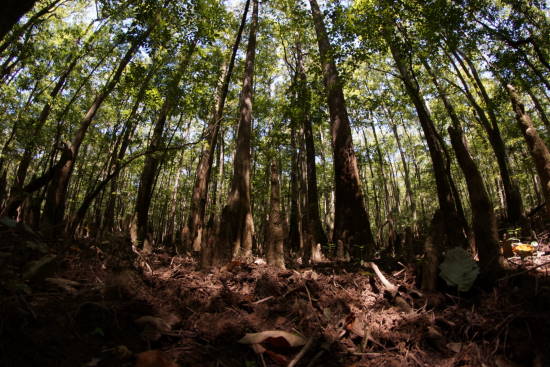Congaree National Park is one of America’s newest national parks, and probably also one of the lesser-known parks. If you compare it to Yellowstone or Yosemite, you may be disappointed. However, Congaree preserves an important ecosystem, and it does offer visitors with some things to see and do — albeit a much more limited selection than at some of the other parks.
Location
Congaree National Park is located southeast of Columbia, South Carolina. Interstate 26 is nearby, but it does not provide easy access.
To reach the park’s main entrance and visitor center, you need to get on its north side, via South Carolina Highway 48 (starting either in Columbia or on US 601). Signs will lead you the rest of the way to the visitor center.
My Visit
The drive through South Carolina can be painfully long and boring. So why not take a break and take a walk through a swamp?
Oh yeah. Mosquitoes. That’s definitely a good reason not to. But, for my visit in late August, the Mosquito Meter at Congaree National Park’s visitor center was slightly below a 2 – meaning I might only suffer a couple of bug bites. I’d hate to see it when it’s at a level 6 – War Zone!
Getting to the visitor center is easy, but it’s probably not what you’d expect. If you’ve been to the big national parks out west, you know that they can be packed with people and hiking trails and viewpoints that inspire awe and wonder. Congaree is different.
The area became a national park in 2003, making it one of the country’s newest national parks. Before that, it was a national monument. Both titles allow the feds to protect the largest tract of old-growth bottomland hardwood forest in the U.S. It’s basically a big swamp filled with cypress trees along the banks of the Congaree River.
That’s why it’s no surprise that the main attraction here is a hike through the swamp. There are several trails, but the only one you really need to know about is the boardwalk loop trail that begins here, at the visitor center.
This isn’t really a hike, it’s a leisurely walk that’s almost entirely flat — although the boardwalk is surprisingly high above the forest floor in places.
The biggest thing to worry about (assuming the mosquitoes are calm) is walking into a big spider web.
Pick up a trail guide before you begin, and you’ll be able to match your location with some fun facts. For example, here at stop #2, you’ll learn that the forest floor is made of mud called Dorovan Muck, which is 8 feet thick. That’s probably the most interesting fact about mud that you’ll hear today.
The boardwalk curves through the forest, past some remarkably sculpted tree trunks…
… and some gardens filled with bizarre-looking nubs called “cypress knees”.
The knees grow out of the roots. It’s unclear exactly why, but it’s believed that the knees provide extra stability to the tree, especially during flooding and windy days.
The trees here are huge — some of the biggest you’ll find in the eastern part of the country. The towering trees seem to wrap around you…
…as they form a canopy above you. The trees average 130 feet tall, making this one of the tallest deciduous forests in the world.
At the far side of the boardwalk loop, you’ll reach an overlook at Weston Lake.
The lake is a remnant of the Congaree River, which used to flow through here, until a course correction isolated this area.
Unfortunately, during my visit in 2014, the backside of the elevated boardwalk was closed. There is an alternative, though: Sims Trail.
This is an old road through the forest. It is not elevated, so you’ll be walking on dirt, and depending on the recent weather, you may also have to navigate around a few puddles. This was the only place where I ran into any hungry mosquitoes.
Whether you take Sims Road or the boardwalk the entire way, you’ll probably end up hiking about 2.5 miles round-trip. I mentioned that there are other trails — but you’ll quickly get the feeling that you’ve seen everything there is to see, once you’ve completed the boardwalk.
Drivelapse Video
The Bottom Line
Congaree National Park is worth a visit, but don’t expect to spend an entire day here (unless you’re especially fascinated by cypress knees and spiders). The boardwalk trail is enjoyable, and will take an hour or two, depending on how fast you’re running from mosquitoes.


















No comments